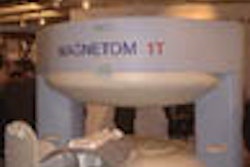While surgical resection remains the gold standard for treating malignant hepatic tumors, many factors conspire to preclude surgery in various patient populations. In the latest issue of RadioGraphics (January 2000, Vol. 20, pp. 9-27), interventional experts review the performance of six percutaneous treatments that are finding success for the treatment of malignant primary and secondary hepatic tumors in nonsurgical patients.
Wider application of ultrasound- and MR-guided techniques, which include radiofrequency ablation, microwave ablation, laser ablation, cryoablation, ethanol ablation, and chemoembolization, promise to markedly increase the role of the interventional radiologist in oncologic therapy. One or more of these procedures, the authors predict, will soon replace surgical resection as the treatment of choice for patients with limited hepatic tumors.
Radiofrequency ablation
Interest in radiofrequency ablation has grown since the first reported use of the technique in 1990, and clinical trials have produced promising results, according to the authors, Drs. Gerald Dodd, Okkes Karahan, and Hyunchul Rhim. The procedure uses a needle electrode with several retractable prongs inserted percutaneously into tumors, which are preferably 3 cm or smaller and not adjacent to blood vessels. The technique works by raising tissue temperatures to about 100° C, and creating a spherical thermal injury of 2-5 cm in the tumor and the surrounding normal hepatic parenchyma. Although both primary and metastatic tumors can be treated, those adjacent to large blood vessels are more difficult to ablate completely, due to the cooling effect of blood flow in the vessels.
Out of a total of 86 patients treated at their clinic, follow-up evaluation was performed in 46, including 25 with hepatocellular carcinoma and 21 with metastases. In a total of 462 procedures, follow-up CT scans showed complete ablation in 71% of the primary carcinomas and in 45% of the metastases. Rare complications included two patients with intrahepatic arterial hemorrhages, two who developed tumor seeding, and the inadvertent ablation of a small area of one patient's diaphragm. Multiple clinical trials showed a 52% complete ablation rate at one year, and survival rates of 96%, 64%, and 40% at one, three, and five years, respectively.
Microwave ablation
Ultrahigh-speed microwave ablation of hepatic tumors began in the early 1990s, using a system developed by Japanese researchers in 1986. Refinements in equipment design and techniques have continued since, with promising clinical results. The procedure uses microwaves to vibrate and rotate water molecules, generating heat and subsequent thermal coagulation in the target tissue. An electrode inserted through a guiding needle produces microwaves of 60 W for 60 seconds; treatments are usually repeated until the entire tumor is ablated. The technique works best with deep tumors, and is generally limited to patients with four or fewer lesions of 5 cm or less each. The technique is effective regardless of the presence of fibrous tissue or a septum.
Dr. Yasuyuki Yamashita reports that his clinic treated 60 patients with 69 hepatocellular carcinomas, mean 28 mm in diameter, with one to 12 microwave emissions in each case. Follow-up with dynamic CT three months later showed complete tumor necrosis in 72% of hepatocellular carcinomas, and incomplete necrosis or tumor recurrence in 28%. The overall survival rate was 83.1% after one year and 68.7% after two years. Complications included ascites in three patients, pleural effusions in two, one case of intraperitoneal hemorrhage, one intraperitoneal abscess, and two cases of needle-tract seeding.
Laser ablation
Since the first laser thermal ablation procedure was reported in 1983, neodymium yttrium aluminum garnet lasers have been used successfully to treat patients with hepatomas and hepatic metastases, according to authors William Lees and Alison Gillams. The procedure uses an array of laser fibers at optical or near-infrared wavelengths to produce light that scatters within tissue and converts to heat, creating coagulative necrosis of about 2 cm in diameter surrounding each fiber. Indications and patient selection are the same as for radiofrequency ablation; however, laser ablation has the advantage of being fully compatible with MRI. The authors note that while sonography is the preferred guidance method when visualization is adequate, MR imaging can add 3D precision at the expense of lengthening the procedure.
Only one death was reported in more than 500 treatment sessions at the authors' clinic, resulting from a spontaneous hepatic infarction six days after a successful procedure. Complications included five patients with segmental infarction, three with abscesses, one with pleural effusion, six with tumor seeding, and pain. The median survival rate was 27 months, and the five-year survival rate 26%, say the authors. They noted that results have improved significantly since 1995 due to technical improvements in the procedure, which again underwent major advances a year ago.
Cryoablation
First suggested for treating liver tumors in 1963, cryoablation is the oldest of the local thermal ablation techniques, according to author Dr. Robert Kane, and may be the best nonsurgical method for treating larger tumors. The procedure works by delivering subfreezing temperatures of -20° C to -30° C with penetrating or surface probes through which a cryogen, such as liquid nitrogen, is circulated. Cryolesions of 6-8 cm can be safely created with the procedure, the author reports. Treatment is generally limited to patients with four or fewer lesions who do not have extrahepatic metastases, or an inability to undergo general anesthesia and laparotomy.
Results were reported for 107 patients over more than 12 years of cryoblation procedures performed in the author's clinic. The mean survival rate was 150 months, and the five-year survival rate was 20%. No deaths have resulted from procedures performed at the clinic, although major complications were reported in fewer than 20% of patients, mostly related to bleeding. No tumor seeding has been found, and tumors recurred in 13% of the patients.
Ethanol ablation
Because it is inexpensive, repeatable and produces good clinical results, enthanol injection is the most accepted of the tumor ablation therapies, according to author Dr. Tito Livraghi. The 95% ethanol injection works by dehydrating cytoplasm, causing coagulation necrosis and subsequent fibrous reaction. The procedure works especially well in cirrhotic patients with hepatocellular carcinoma; however, it is largely ineffective in treating metastatic lesions. For multiple carcinomas, ethanol ablation is generally less toxic and better controlled than chemoembolization, but it should not be used in patients with extrahepatic disease, thrombosis of the portal vein or low platelet count, among other contraindications.
The author reported complete ablation in 70% to 75% of patients with hepatocellular carcinomas of 5-8 cm or less, and about 60% in encapsulated hepatocellular carcinomas. Depending on patient age, size, and number of carcinomas, survival rates ranged from 74% to 98% at one year, 42% to 79% at three years and 36% to 47% at five years. Following multisession percutaneous injection, major complications were seen in 1.7% of patients, and included peritoneal hemorrhage, hemobilia and liver abscess. No deaths were reported. Following one-shot injection, major complications or death occurred in 4.6% and 0.7% of patients, respectively.
Chemoembolization
This procedure has been performed in more patients than the other five nonsurgical therapies combined, and although results have been good, according to author Dr. Michael Soulen, the search for the best combination of chemotherapeutic agents continues. Hepatic malignancies receive 95% of their blood supply from the hepatic artery, as opposed to normal liver tissue, which receives 75% of its blood supply from the portal vein and 25% from the hepatic artery. Because of this, hepatic artery embolization selectively induces ischemic necrosis in tumors, while the normal liver tissue survives on the portal blood supply. Contraindications include absence of hepatopedal portal flow, encephalopathy, bilial obstruction and cardiac or renal insufficiency.
The response rate for most primary and metastatic tumors ranges from 60% to 80%, with an average duration of one year, according to the author, and recurrent tumors can be retreated. Survival rates were 70% at one year, 40% at three years and 10% at five years. The survival rates varied widely depending on various prognostic factors. Serious complications occur after 5% of procedures, most commonly liver abscess or necrosis. The 30-day mortality rate is 1% to 3%.
Conclusion
For patients who are not surgical candidates, it is not difficult to improve on the response rate of systemic chemotherapy, which is reported to be around 15% to 20%, according to the authors. Of the six therapies described in the RadioGraphics report, cryoablation has the best results, with a local tumor recurrence rate of 15%. However, cryoablation shares many of the drawbacks of hepatic resection. Chemoembolization does not offer the chance of a cure, and should therefore not be used when resection is possible. Ethanol ablation is especially effective for treating small hepatic tumors, and can be repeated. The three thermal techniques -- radio-frequency, microwave and laser ablation -- are still in their infancy, and while all of them are effective in debulking tumors, they also yield complete ablation rates of less than 90% with current technology. Together, the techniques show great promise for the treatment of primary and secondary hepatic malignancies. One or more of them will replace most hepatic resections in the near future, the authors predict.
The complete source article is available at http://radiographics.rsnajnls.org/cgi/content/full/20/1/9.
By Eric Barnes
AuntMinnie.com staff writer
February 15, 2000
Copyright © 2000 AuntMinnie.com


















